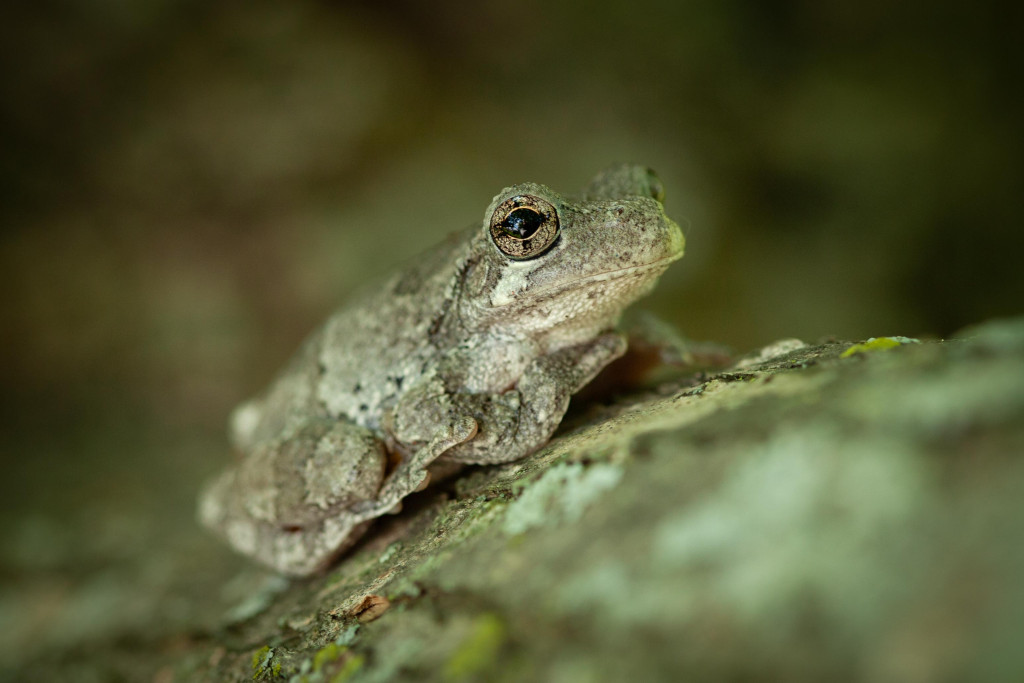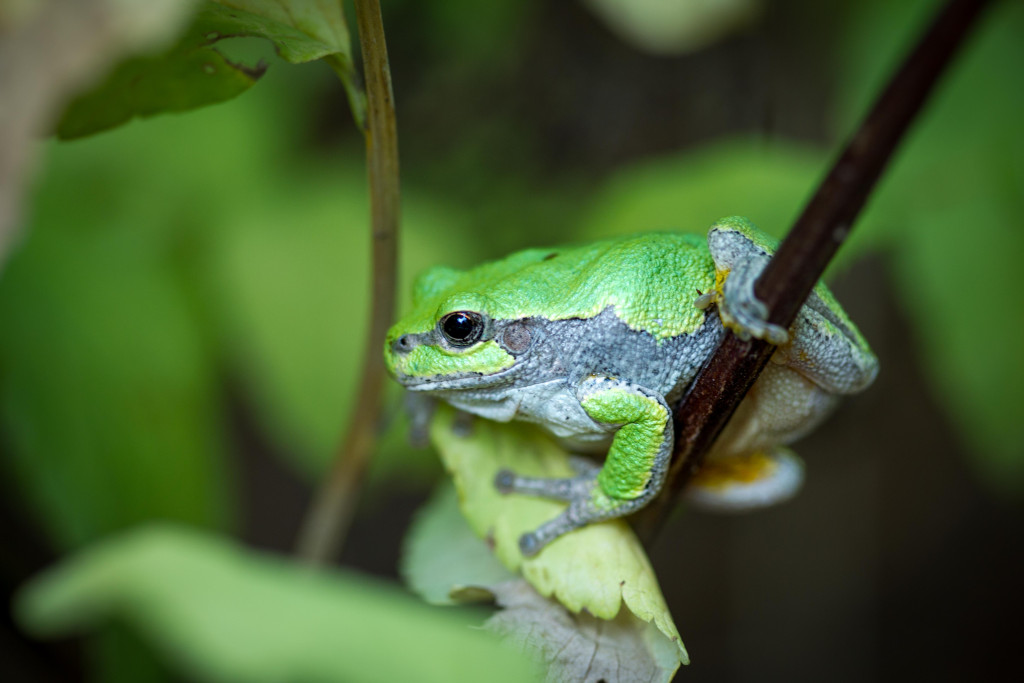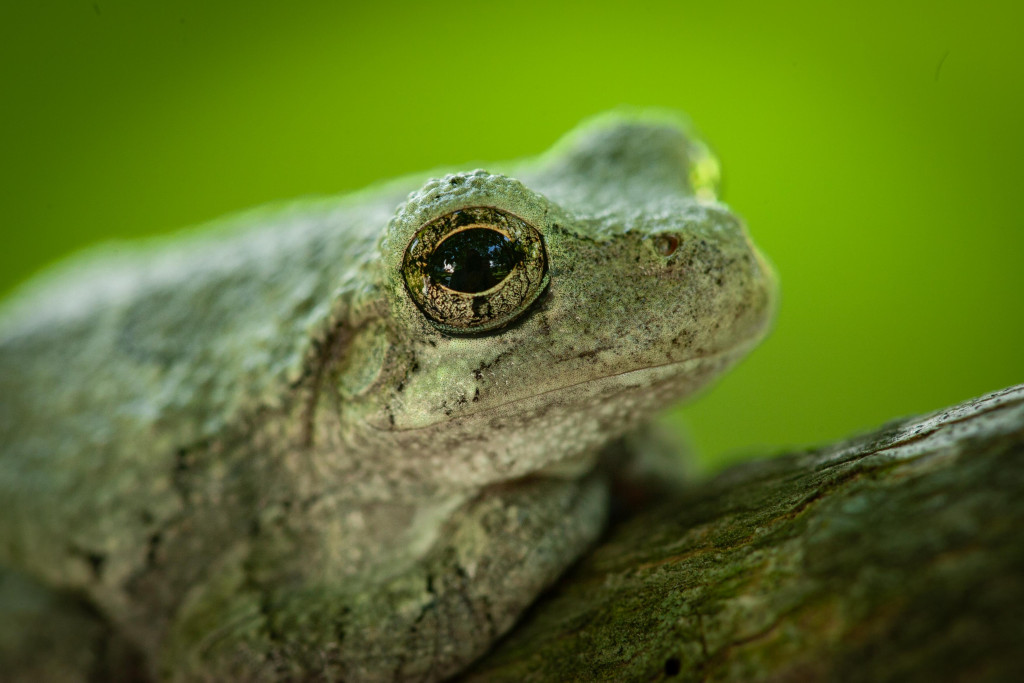The Cope’s gray treefrog plays a vital role in forest and wetland ecosystems of Nebraska.
Enlarge

Photo by Doug Carroll, Nebraskaland Magazine
By Monica Macoubrie, Wildlife Education Specialist
Meet the Cope’s gray treefrog (Hyla chrysoscelis), a captivating amphibian found across eastern North America. Sporting subtle grays and greens adorned with intricate patterns on its skin, this arboreal frog is celebrated for its adaptability and enchanting calls. Despite its small size, this treefrog plays a vital role in the forest and wetland ecosystems where it lives.
Appearance
When considering a treefrog, our minds often envision vibrant colors that mirror the lush foliage and flowers of the rainforest. In Nebraska, the Cope’s gray treefrog’s striking appearance blends seamlessly with its arboreal habitat.
Usually ranging 1.5 to 2 inches long, this amphibian displays a muted spectrum of gray or green tones along its dorsal (upper) surface. Its skin is often decorated with intricate markings, varying from dark blotches to elaborate arrangements of lines and spots, offering effective concealment amidst tree bark and foliage. A distinctive dark mask extends from the snout to the eye, accentuating its expressive appearance.
Large, adhesive toe pads enable the Cope’s gray treefrog to effortlessly climb and cling to various surfaces, aiding its arboreal lifestyle.

Behavior and Special Adaptations
In Nebraska, Cope’s gray treefrogs exhibit fascinating behaviors and possess special adaptations that enable them to thrive in diverse environments. These arboreal amphibians are predominantly nocturnal, seeking refuge in shaded areas or tree cavities during the day and emerging at night to forage for food. Their cryptic coloration and markings provide effective camouflage against predators such as birds, snakes and mammals.
Cope’s gray treefrogs are renowned for their remarkable climbing ability, aided by large, adhesive toe pads that enable them to cling to various surfaces, including tree bark and foliage. Their adhesive toe pads also facilitate efficient hunting, as they can quickly snatch insects and other small invertebrates from vegetation. Furthermore, these frogs possess specialized vocal sacs that allow males to produce loud, melodious calls during the breeding season, serving to attract potential mates and establish territories.
During winter, Cope’s gray treefrogs experience a remarkable adaptation known as crypsis, where they undergo a process called cryoanesthesia. As temperatures drop, these amphibians enter a state of dormancy and seek shelter in leaf litter or soil. They accumulate glycerol and glucose in their tissues, which act as a natural antifreeze to prevent ice crystals from forming within their bodies. In this frozen state, their metabolism slows dramatically, allowing them to survive freezing temperatures until warmer conditions return in spring.
Distribution and Habitat
The Cope’s gray treefrog inhabits a variety of habitats across the state. From the sprawling prairies to the lush woodlands and wetlands, these adaptable amphibians can be encountered in a range of environments. They demonstrate a preference for moist habitats near water bodies such as ponds, marshes and slow-moving streams, where they find ample opportunities for breeding and foraging. However, they are also known to thrive in suburban gardens, parks and agricultural areas with suitable vegetation and moisture levels.
Despite their versatile nature, habitat loss and fragmentation due to urbanization, agriculture and land development pose significant threats to their populations in Nebraska. Conservation efforts aimed at preserving and restoring their preferred habitats are crucial for ensuring the continued presence of the Cope’s gray treefrog throughout the Cornhusker State.

Reproduction and Lifecycle
In Nebraska, the lifecycle and reproductive habits of the Cope’s gray treefrog follow a seasonal rhythm intertwined with the state’s climate. Breeding typically occurs from late spring to early summer, with males congregating near water bodies, filling the night air with their melodious calls to attract females. The call of the Cope’s gray treefrog resembles a series of high-pitched trills or peeps, adding to the soothing nighttime chorus in Nebraska’s wetlands.
Upon successful mating, females lay their eggs in shallow water, attaching them to submerged vegetation or debris. These eggs hatch into tadpoles, which undergo metamorphosis over several weeks, eventually emerging as miniature froglets. Environmental factors such as temperature and precipitation play critical roles in determining the timing and success of reproduction.
Conservation Status and Threats
In Nebraska, conservation of the Cope’s gray treefrog faces a complex array of threats amidst efforts to preserve its populations. While currently categorized as a species of least concern on the International Union for Conservation of Nature Red List, these arboreal amphibians confront significant challenges that warrant attention. Habitat loss and fragmentation due to urbanization, agricultural expansion and land development pose primary threats to their survival. Wetland degradation and pollution from pesticides, herbicides and runoff further degrade their breeding habitats and impact water quality, jeopardizing their reproductive success.
Additionally, climate change presents an emerging threat, altering precipitation patterns and temperatures, which could disrupt breeding cycles and habitat suitability. These cumulative stressors highlight the urgency of conservation efforts to safeguard Cope’s gray treefrog populations in Nebraska.
Collaborative initiatives involving government agencies, conservation organizations, researchers and local communities are essential to implementing habitat restoration, monitoring programs and education outreach to mitigate these threats and ensure the long-term viability of this species in the state’s ecosystems.

Community Science and Engagement
Community science plays a vital role in monitoring and conserving Cope’s gray treefrog populations in Nebraska. Through community science programs, volunteers can contribute valuable data on frog distribution, abundance and habitat preferences through frog call surveys, habitat assessments and population monitoring initiatives. These efforts not only provide scientists with important information for research and management but they also foster a deeper connection between people and nature. Community scientists become ambassadors for the Cope’s gray treefrog, advocating for its conservation and inspiring others to take action to safeguard Nebraska’s natural heritage for future generations.
By involving citizens in conservation activities, such as habitat restoration projects and educational outreach events, we can raise awareness about the importance of protecting amphibian habitats and promoting biodiversity conservation. For more information on how to become a community scientist, visit scistarter.org
The post Cope’s Gray Treefrog appeared first on Nebraskaland Magazine.
















